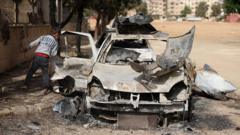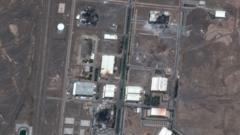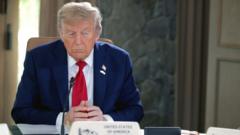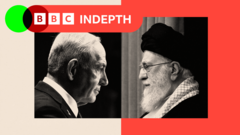Recent clashes in Syria's Druze areas near Damascus have raised fears of potential widespread unrest, driven by longstanding tensions and external interference from countries like Israel. The violence has prompted a desperate call for unity and stability as the fallout from the civil war continues to threaten fragile communities.
Escalating Violence in Syria's Druze Regions Raises Alarming Concerns of Wider Conflict

Escalating Violence in Syria's Druze Regions Raises Alarming Concerns of Wider Conflict
Clashes in Syria involving Druze civilians and armed factions signal deeper tensions and external influences, casting doubt on prospects for peace.
Article Text:
Violence has erupted anew in the Druze regions of Syria, particularly around Damascus, leading to fresh fears of an all-encompassing conflict. Armed confrontations between Islamist factions, security forces, and Druze militias have highlighted the precarious state of the nation's security landscape post-Bashar al-Assad, as well as the persistent outside intervention that complicates the situation.
In a pronounced show of support for the Druze population, Israel conducted air strikes aimed at protecting civilians during the turmoil, exacerbating concerns about the country's fractious state following years of devastating civil war and authoritarian rule under the Assad regime. These events have underscored the varied factions vying for power, along with mistrust of the newly formed Syrian authorities, whose loyalty is questioned due to their jihadist connections.
The Syrian landscape is marred by divisions, with significant regions—such as Idlib, held by the Hayat Tahrir al-Sham faction, and northeastern areas under Kurdish control—operating in varying degrees of autonomy. The latest clashes involved various armed groups and Druze fighters, showcasing the melange of actors still influencing the conflict.
March's confrontation, which resulted in numerous casualties, remains a stark reminder of the violent volatility in regions such as Alawite-controlled areas, despite Assad's regime trying to reassert dominance in urban centers. The recent fighting near the town of Ashrafiyat Sahnaya left 101 people dead, including 71 Druze and 30 members of security forces, marking a tragic escalation of violence.
In response, Syrian authorities stated they would deploy security forces in Sahnaya to combat what they described as “outlaw groups,” while Druze leaders condemned the military actions as part of an "unjustifiable genocidal campaign". A ceasefire has reportedly been established momentarily, yet the underlying tensions, particularly stoked by provocations on social media, signal a perilous environment.
The regional dynamic continues to be complicated by Israel’s territorial ambitions and engagement with the Druze community. Israeli Prime Minister Netanyahu's demand for the demilitarization of southern provinces further threatens to undermine the Syrian government's attempts to stabilize the region, as tensions heighten with Turkey's disapproval of Israeli interventions.
As multiple outside forces act in their own interests, the path toward a unified and stable Syria remains fraught with challenges. The country’s need for external support, both financial and political, is ever more critical in efforts to achieve a lasting peace for its war-torn populace.
Violence has erupted anew in the Druze regions of Syria, particularly around Damascus, leading to fresh fears of an all-encompassing conflict. Armed confrontations between Islamist factions, security forces, and Druze militias have highlighted the precarious state of the nation's security landscape post-Bashar al-Assad, as well as the persistent outside intervention that complicates the situation.
In a pronounced show of support for the Druze population, Israel conducted air strikes aimed at protecting civilians during the turmoil, exacerbating concerns about the country's fractious state following years of devastating civil war and authoritarian rule under the Assad regime. These events have underscored the varied factions vying for power, along with mistrust of the newly formed Syrian authorities, whose loyalty is questioned due to their jihadist connections.
The Syrian landscape is marred by divisions, with significant regions—such as Idlib, held by the Hayat Tahrir al-Sham faction, and northeastern areas under Kurdish control—operating in varying degrees of autonomy. The latest clashes involved various armed groups and Druze fighters, showcasing the melange of actors still influencing the conflict.
March's confrontation, which resulted in numerous casualties, remains a stark reminder of the violent volatility in regions such as Alawite-controlled areas, despite Assad's regime trying to reassert dominance in urban centers. The recent fighting near the town of Ashrafiyat Sahnaya left 101 people dead, including 71 Druze and 30 members of security forces, marking a tragic escalation of violence.
In response, Syrian authorities stated they would deploy security forces in Sahnaya to combat what they described as “outlaw groups,” while Druze leaders condemned the military actions as part of an "unjustifiable genocidal campaign". A ceasefire has reportedly been established momentarily, yet the underlying tensions, particularly stoked by provocations on social media, signal a perilous environment.
The regional dynamic continues to be complicated by Israel’s territorial ambitions and engagement with the Druze community. Israeli Prime Minister Netanyahu's demand for the demilitarization of southern provinces further threatens to undermine the Syrian government's attempts to stabilize the region, as tensions heighten with Turkey's disapproval of Israeli interventions.
As multiple outside forces act in their own interests, the path toward a unified and stable Syria remains fraught with challenges. The country’s need for external support, both financial and political, is ever more critical in efforts to achieve a lasting peace for its war-torn populace.























